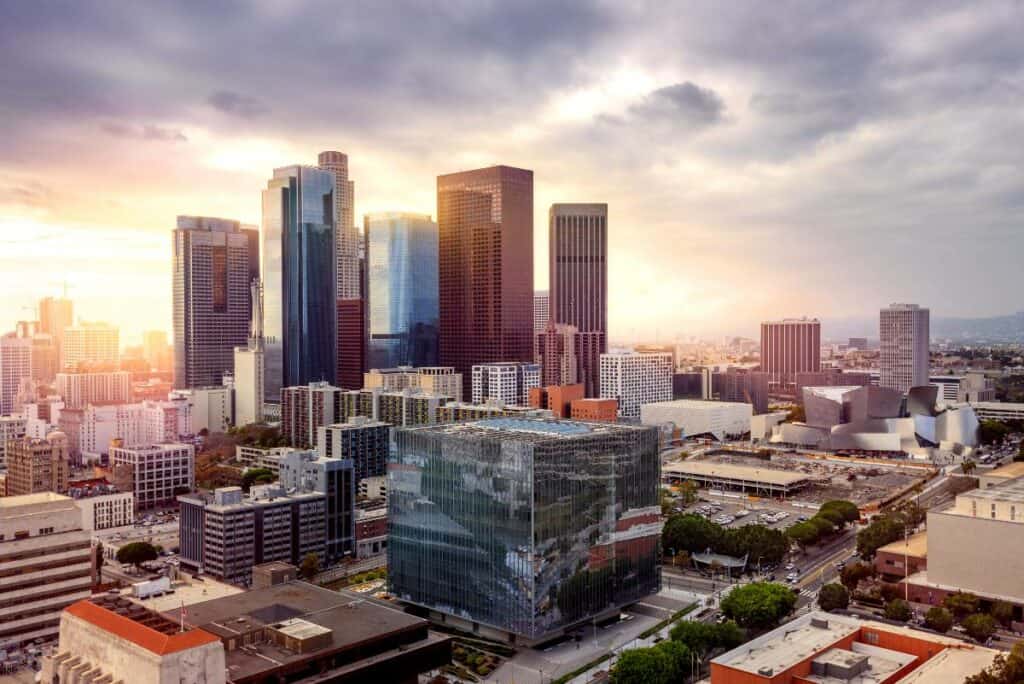As a seasoned professional in the commercial real estate industry, I’ve seen firsthand how understanding zoning laws can make or break a project. In a city as vast and diverse as Los Angeles, navigating the complexities of zoning regulations is essential for any property owner, developer, or business. Whether you’re looking to lease or sell a commercial property or embark on a new development venture, having a solid grasp of the zoning landscape can save you time, money, and headaches. In this article, we’ll dive into the world of Los Angeles zoning laws and explore how you can use this knowledge to your advantage.
Key Takeaways
- Understanding Los Angeles zoning laws is crucial for property owners, developers, and businesses
- The Los Angeles City Planning Department plays a vital role in administering zoning codes and guiding development
- Familiarizing yourself with zoning classifications, tools, and processes can help you make informed decisions and avoid potential pitfalls
Table of Contents
Everything You Must Understand About Zoning Laws in Los Angeles
What is Zoning and How Does it Affect Land Use?
Zoning is a regulatory tool used by local governments to control and guide land development. It involves dividing a city or county into distinct zones, each with its own set of rules and restrictions governing the use, size, and development of properties within that zone. The primary purpose of zoning is to ensure that land is used efficiently, safely, and in a manner that promotes the general welfare of the community. By specifying the permitted uses and development standards for each zone, zoning laws play a crucial role in shaping the physical and social character of neighborhoods and cities.
Understanding Zoning Zones in Los Angeles
Los Angeles has a complex system of zoning zones, each designed to accommodate specific land uses and development patterns. The main categories of zones include:
| Zone Category | Description |
|---|---|
| Residential | Ranges from low-density single-family neighborhoods to high-density apartment districts |
| Commercial | Includes local corner stores, large shopping centers, and everything in between |
| Industrial | Accommodates manufacturing, warehousing, and other heavy commercial activities |
| Agricultural | Allows for farming, ranching, and related activities |
Understanding the specific zoning designation of a property is essential for anyone looking to buy, sell, or develop land in Los Angeles.
Exploring the Relationship Between Land Use and Zoning Laws
Land use and zoning laws are closely intertwined, with each influencing the other in significant ways. Zoning laws determine the permitted land uses within each zone, which in turn shapes the overall land use patterns of a city or region. For example:
- Zoning laws that allow for a mix of residential and commercial uses in the same area can promote walkable, vibrant neighborhoods.
- Strict separation of uses can lead to more sprawling, car-dependent development patterns.
At the same time, changes in land use, such as the growth of a particular industry or demographic shifts, can drive changes in zoning laws to accommodate new needs and preferences.
Exploring the Relationship Between Land Use and Zoning Laws
Land use and zoning laws are closely intertwined, with each influencing the other in significant ways. Zoning laws determine the permitted land uses within each zone, which in turn shapes the overall land use patterns of a city or region. For example, zoning laws that allow for a mix of residential and commercial uses in the same area can promote walkable, vibrant neighborhoods, while strict separation of uses can lead to more sprawling, car-dependent development patterns. At the same time, changes in land use, such as the growth of a particular industry or demographic shifts, can drive changes in zoning laws to accommodate new needs and preferences.
Zoning Basics
At its core, zoning is a tool used by local governments to regulate land use and development. It dictates what types of buildings and activities are allowed in specific areas to promote public health, safety, and welfare. In Los Angeles, zoning laws are divided into several main categories:
- Residential: Single-family homes, multi-family dwellings, and apartments
- Commercial: Retail stores, offices, restaurants, and hotels
- Industrial: Manufacturing, warehouses, and distribution centers
- Agricultural: Farming, ranching, and related activities
Each of these categories is further broken down into specific zones, such as R1 for single-family residential or C2 for general commercial. Understanding which zone your property falls under is the first step in determining what you can and cannot do with it.
Los Angeles City Planning Department
The Los Angeles City Planning Department is the government agency responsible for administering and enforcing the city’s zoning laws. They handle a wide range of tasks, including:
- Reviewing and approving development applications
- Maintaining and updating the zoning code
- Preserving historic resources
- Promoting urban design principles
One of the department’s key roles is to ensure that all development projects comply with the city’s General Plan, which outlines the long-term vision for land use and growth in Los Angeles. They also work closely with other agencies, such as the Department of Building and Safety, to streamline the permitting process and address any zoning-related issues that may arise.
As a property owner or developer, it’s essential to establish a good working relationship with the City Planning Department. They can provide valuable guidance and resources to help you navigate the zoning process and achieve your goals.
Residential Zoning in Los Angeles
Residential zoning is perhaps the most well-known and widely discussed aspect of land use regulation in Los Angeles. The city is divided into several residential zones, each with its own set of rules and requirements:
- Single-family zones (R1, RW1, RW2): These zones are intended for detached single-family homes, with varying lot sizes and building heights allowed depending on the specific classification.
- Multi-family zones (R2, RD2-RD6, R3-R5): These zones allow for duplexes, triplexes, apartments, and condominiums, with increasing density and building size as the numbers go up.
In recent years, there has been a growing interest in Accessory Dwelling Units (ADUs), also known as granny flats or in-law suites. These are secondary housing units that can be built on the same lot as a single-family home. The city has recently updated its zoning laws to make it easier for homeowners to build ADUs, to address the housing shortage and provide more affordable options for renters.
When considering a residential development project, it’s crucial to understand the density and building requirements for your specific zone. This includes factors such as:
- Maximum number of units allowed per lot
- Minimum lot size and width
- Setbacks from property lines
- Height and floor area ratio (FAR) limits
Working with a knowledgeable real estate professional or zoning consultant can help you navigate these requirements and ensure that your project is feasible and compliant.
Commercial and Industrial Zoning
Commercial and industrial zoning are essential for businesses looking to operate in Los Angeles. The city has several commercial zones, each with its own set of allowed uses and development standards:
- CR (Limited Commercial): Small-scale retail and office uses
- C1 (Neighborhood Commercial): Local-serving businesses, such as grocery stores and restaurants
- C2 (Community Commercial): A wider range of retail, service, and office uses
- C4 (Commercial): High-intensity commercial areas, such as regional shopping centers
- C5 (Commercial): Specialized commercial uses, such as hotels and motels
Industrial zones, on the other hand, are designed to accommodate manufacturing, warehousing, and other heavy commercial activities. The two main industrial zones in Los Angeles are:
- MR1 (Restricted Industrial): Light manufacturing and limited commercial uses
- M3 (Heavy Industrial): More intensive industrial activities, with fewer restrictions on uses
One growing trend in commercial and industrial zoning is the development of mixed-use projects, which combine residential units with retail, office, or other commercial spaces. These projects can help create more vibrant and walkable communities, while also providing housing and economic opportunities. However, they also come with their own set of zoning considerations, such as:
- Ensuring compatible uses and minimizing conflicts between residents and businesses
- Meeting parking and open space requirements for both residential and commercial components
- Adhering to building height and density limits
As with residential projects, it’s important to work with experienced professionals who can help you navigate the complexities of commercial and industrial zoning in Los Angeles.

Special Zoning Designations and Overlays
In addition to the standard zoning classifications, Los Angeles also has several special designations and overlays that can impact development in certain areas. These include:
- Specific Plans: Customized zoning regulations for defined geographic areas, are often used to guide growth and development in a particular neighborhood or community.
- Historic Preservation Overlay Zones (HPOZs): Areas with significant concentrations of historic buildings, where new development must adhere to specific design guidelines to maintain the area’s character.
- Community Design Overlays (CDOs): Similar to HPOZs, but focused on promoting high-quality design and pedestrian-friendly development in commercial areas.
- Pedestrian Oriented Districts (PODs): Areas where zoning regulations are tailored to encourage walkable, mixed-use development and enhance the pedestrian experience.
These special designations can add an extra layer of complexity to the zoning process, but they also present unique opportunities for developers and businesses to create projects that contribute to the character and vitality of Los Angeles’s diverse neighborhoods.
Zoning and Environmental Considerations
Zoning laws in Los Angeles are closely intertwined with environmental regulations, particularly the California Environmental Quality Act (CEQA). CEQA requires that development projects undergo an environmental review process to identify and mitigate any potential negative impacts on the environment.
For larger projects, this may involve preparing an Environmental Impact Report (EIR), which assesses the project’s effects on factors such as air and water quality, traffic, and wildlife habitat. Smaller projects may be able to qualify for a streamlined review process or exemption, depending on their scope and location.
In recent years, there has been a growing emphasis on sustainable development practices in Los Angeles, with the city adopting policies to encourage green building, renewable energy, and transit-oriented development. Zoning laws have begun to reflect these priorities, with incentives for projects that incorporate environmentally friendly features or are located near public transportation.
As a developer or property owner, it’s important to factor in environmental considerations early in the planning process, to avoid delays or roadblocks down the line. Working with experienced consultants and attorneys can help you navigate the CEQA process and ensure that your project is both legally compliant and environmentally responsible.
Navigating the Zoning Process
Navigating the zoning process in Los Angeles can be complex, but with the right knowledge and support, it doesn’t have to be overwhelming. Here are some key steps and considerations to keep in mind:
- Determine your property’s zoning classification: Use tools like ZIMAS (Zoning Information and Map Access System) to find out how your property is zoned and what uses are allowed.
- Understand any special designations or overlays: Check if your property falls within any Specific Plans, HPOZs, CDOs, or other special zoning areas that may have additional requirements or restrictions.
- Identify any needed zoning changes or approvals: If your proposed use or development is not allowed under the current zoning, you may need to apply for a variance, conditional use permit, or zone change. This can be a lengthy and complex process, so it’s important to work with experienced professionals who can guide you through it.
- Engage with the community and address concerns: Zoning changes and development projects can sometimes face opposition from neighbors or community groups. It’s important to engage with stakeholders early on, listen to their concerns, and work to find mutually beneficial solutions.
- Work closely with the Los Angeles City Planning Department: The Planning Department is your key partner in the zoning process. They can provide guidance on application requirements, review timelines, and any potential obstacles or opportunities related to your project.
Remember, navigating the zoning process takes time, patience, and a willingness to collaborate with others. But with the right approach, you can successfully achieve your development goals while contributing to the vibrant and dynamic fabric of Los Angeles.

Understanding Zoning Maps and Tools
One of the most valuable resources for understanding zoning in Los Angeles is the Zoning Information and Map Access System (ZIMAS). This online tool allows you to search for properties by address or parcel number and view detailed information about their zoning classifications, permitted uses, and development standards.
To use ZIMAS effectively, it’s important to know how to read and interpret zoning maps. These maps use a color-coded system to represent different zoning classifications, with each color corresponding to a particular use category (e.g., yellow for residential, red for commercial). The maps also include symbols and labels to indicate specific zoning designations, such as height districts or overlay zones.
In addition to ZIMAS, the Los Angeles City Planning Department offers a variety of other tools and resources to help property owners and developers navigate the zoning process. These include:
- The Zoning Code Manual, which provides a comprehensive overview of the city’s zoning regulations and procedures
- Community Plans, which outline the specific land use goals and policies for each of the city’s 35 community plan areas
- Public counters and case management services, where you can meet with Planning Department staff to discuss your project and get guidance on the application process
By familiarizing yourself with these tools and resources, you can more easily determine the zoning requirements and opportunities for your property, and make informed decisions about your development plans.
FAQs
What factors control zoning in Los Angeles?
Zoning in Los Angeles is controlled by a variety of factors, including the city’s General Plan, community plans, and specific plans. These plans establish the overall goals and policies for land use and development in the city, and are implemented through the zoning code and map.
How can I determine the zoning of my property?
The easiest way to determine the zoning of your property is to use the Zoning Information and Map Access System (ZIMAS). Simply enter your property address or parcel number, and ZIMAS will provide detailed information about the zoning classification, permitted uses, and development standards for your property.
What are the main differences between residential and commercial zoning?
Residential zoning is intended for housing, while commercial zoning is intended for businesses and other non-residential uses. Residential zones are typically more restrictive in terms of density, height, and lot coverage, while commercial zones allow for a wider range of uses and development intensities.
How do I ensure my development project adheres to zoning regulations?
To ensure your development project adheres to zoning regulations, it’s important to work closely with the Los Angeles City Planning Department and other relevant agencies. This may involve submitting plans and applications for review, attending public hearings, and making any necessary revisions or adjustments to your project to meet zoning requirements.
Can zoning laws change, and how does that affect property owners?
Yes, zoning laws can change over time, through processes such as zone changes, variances, and amendments to the zoning code. These changes can affect property owners by allowing new uses or development opportunities, or by imposing new restrictions or requirements. It’s important to stay informed about any proposed or adopted zoning changes that may impact your property, and to work with the Planning Department to understand your rights and options.
Conclusion
Understanding Los Angeles zoning laws is a critical component of success for any property owner, developer, or business in the city. By familiarizing yourself with the different zoning classifications, tools, and processes, you can make informed decisions about your real estate investments and development plans.
Remember, navigating the complexities of zoning can be challenging, but you don’t have to go it alone. Working with experienced professionals, like Mike Tolj , can help you avoid potential pitfalls and achieve your goals more efficiently.
With over 18 years of experience in the commercial real estate industry, Mike has a deep understanding of the Los Angeles zoning landscape and a proven track record of success in helping clients lease, sell, and develop properties. Whether you’re a business owner looking for the perfect location, or a landlord seeking to maximize the value of your property, Mike and his team at Tolj Commercial can provide the expertise and guidance you need.
Don’t let zoning complexities stand in the way of your real estate dreams. Schedule a consultation with Tolj Commercial today and take the first step towards achieving your goals in the dynamic and exciting world of Los Angeles commercial real estate.




